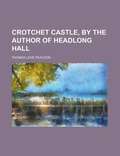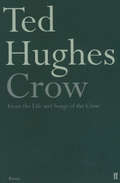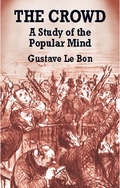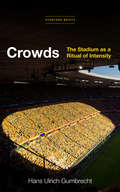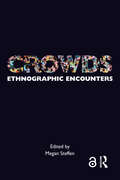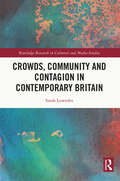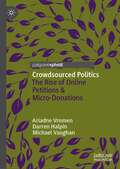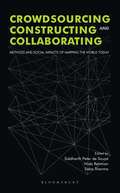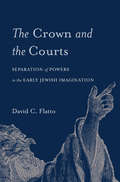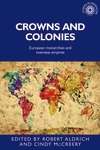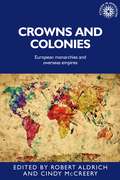- Table View
- List View
Crossroads of Rural Crime: Representations and Realities of Transgression in the Australian Countryside
by Alistair HarknessRural-oriented scholarship in criminology is growing, in part motivated by governmental, community and academic recognition that, despite stereotypes of the 'rural idyll', crime and justice are significant issues in the rural landscape. Using the notion of 'crossroads' to provide a unique lens through which to examine realities of rural crime, Crossroads of Rural Crime: Representations and Realities of Transgression in the Australian Countryside provides a dynamic understanding of the nature of rural life and ways in which transgression manifests itself in the context of a presumed rural-urban divide. Common myths regarding rural crime are challenged by exploring its diverse dimensions from a central conceptual focal point; the many 'roads' that lead into and out of rural spaces, whether literal, virtual or figurative. With a focus on the Australian countryside, the authors examine issues such as drug abuse, persecution of wildlife, rural penal practices, and health in Indigenous communities. The first substantive edited collection to focus on notions of the mobility of crime within, to and from rural spaces, this interdisciplinary collection draws together contributions from criminology, politics, sociology, Indigenous studies, literature and anthropology to significantly contribute to our understanding of rural crime.
Crossroads of Rural Crime: Representations and Realities of Transgression in the Australian Countryside
by Alistair Harkness Rob WhiteRural-oriented scholarship in criminology is growing, in part motivated by governmental, community and academic recognition that, despite stereotypes of the 'rural idyll', crime and justice are significant issues in the rural landscape. Using the notion of 'crossroads' to provide a unique lens through which to examine realities of rural crime, Crossroads of Rural Crime: Representations and Realities of Transgression in the Australian Countryside provides a dynamic understanding of the nature of rural life and ways in which transgression manifests itself in the context of a presumed rural-urban divide. Common myths regarding rural crime are challenged by exploring its diverse dimensions from a central conceptual focal point; the many 'roads' that lead into and out of rural spaces, whether literal, virtual or figurative. With a focus on the Australian countryside, the authors examine issues such as drug abuse, persecution of wildlife, rural penal practices, and health in Indigenous communities. The first substantive edited collection to focus on notions of the mobility of crime within, to and from rural spaces, this interdisciplinary collection draws together contributions from criminology, politics, sociology, Indigenous studies, literature and anthropology to significantly contribute to our understanding of rural crime.
Crotchet Castle
by Thomas Love PeacockCrotchet Castle (1831), his sixth novel, contains all the humour and social satire for which Peacock is famous. Its lively farce is more ambitious than that of the earlier works in its range of cultural and intellectual targets, including progressivism, dogmatism, liberalism, sexism, mass education and the idiocies of the learned. The book constitutes an artistic, political and philosophical miscellany of sorts, thematically unified in its satirical emphasis on folly and dispute – and on the folly of dispute itself.
Crow: From The Life And Songs Of The Crow (Faber Pocket Poetry Ser. #Vol. 5)
by Ted HughesCrow was Ted Hughes's fourth book of poems for adults and a pivotal moment in his writing career. In it, he found both a structure and a persona that gave his vision a new power and coherence. A deep engagement with history, mythology and the natural world combine to forge a work of impressive and unsettling force. 'English poetry has found a new hero and nobody will be able to read or write verse now without the black shape of Crow falling across the page.' Peter Porter
Crow Indian Rock Art: Indigenous Perspectives and Interpretations
by Timothy P McClearyThis absorbing volume examines the cultural role of rock art for the Apsáalooke, or Crow, people of the northern Great Plains. Their extensive rock art developed within the changing cultural life of the tribe. Individual knowledge and meaning of rock art panels, however, relies as much on collective concepts of landscape as it does on shared memories of historic Crow culture. Using this idea as a focus, this book:-introduces Plains Indian rock art of the 19th century as we know about it from its own stylistic conventions, ethnographic data, and historical accounts;-investigates the contemporary Crow discourse about rock art and its place within the cultural landscape and archaeological record;-argues that cultural concepts of space and place are fundamental to the way rock art is discussed, experienced and interpreted.
Crow Indian Rock Art: Indigenous Perspectives and Interpretations
by Timothy P McClearyThis absorbing volume examines the cultural role of rock art for the Apsáalooke, or Crow, people of the northern Great Plains. Their extensive rock art developed within the changing cultural life of the tribe. Individual knowledge and meaning of rock art panels, however, relies as much on collective concepts of landscape as it does on shared memories of historic Crow culture. Using this idea as a focus, this book:-introduces Plains Indian rock art of the 19th century as we know about it from its own stylistic conventions, ethnographic data, and historical accounts;-investigates the contemporary Crow discourse about rock art and its place within the cultural landscape and archaeological record;-argues that cultural concepts of space and place are fundamental to the way rock art is discussed, experienced and interpreted.
The Crowd: A Study of the Popular Mind
by Gustave Le BonOne of the most influential works of social psychology in history, The Crowd was highly instrumental in creating this field of study by analyzing, in detail, mass behavior. The book had a profound impact not only on Freud but also on such twentieth-century masters of crowd control as Hitler and Mussolini — both of whom may have used its observations as a guide to stirring up popular passions. In the author's words, "The masses have never thirsted after the truth. Whoever can supply them with illusions is easily their master; whoever attempts to destroy their illusions is always their victim."Although the volume focuses on crowd psychology, it is also brilliantly instructive on the effects of the generally accepted beliefs of a nation's citizenry on the processes of history. Among the topics covered here are general characteristics and mental unity of the crowd; the crowd's sentiments and morality; its ideas, reasoning power, and imagination; opinions and beliefs of crowds and the means used by leaders to persuade; classification of crowds, including criminal and electrical assemblages, as well as the functioning of criminal juries and parliamentary assemblies.A must-read volume for students of history, sociology, law, and psychology, The Crowd will also be invaluable to politicians, statesmen, investors, and marketing managers.
Crowd Actions in Britain and France from the Middle Ages to the Modern World
by Michael T. DavisCrowd Actions in Britain and France from the Middle Ages to the Modern World explores the lively and often violent world of the crowd, examining some of the key flashpoints in the history of popular action. From the Peasants' Revolt of 1381 to the Paris riots in 2005 and 2006, this volume reveals what happens when people gather together in protest.
A Crowd of One: The Future of Individual Identity
by John ClippingerGreat leaps forward in scientific understanding have, throughout history, engendered similar leaps forward in how we understand ourselves. Now, the new hybrid disciplines of evolutionary biology and social physics are making the next leap possible-and fundamentally altering our notions of individual identity. If identity is a fact not derived from within the individual, but conferred on an individual by a group, or network, a host of assumptions about how governments work, how conflicts arise and are resolved, and how societies can be coaxed toward good are overturned. John Clippinger brilliantly illuminates how the Enlightenment itself-the high point of individual assertiveness-was a product not just of a few moments of individual inspiration and creativity, but rather of a societal shift that allowed innovation and creativity to flourish. Michelangelo owes quite as much to the circumstances of the Renaissance as the Renaissance does to the work of Michelangelo. Now, the digitalization of society, which affects all of us already, allows new insight into these questions: What does it require for societies, organizations and individuals, to thrive? Who decides who you are? How can happiness be shared and spread? Who can you trust?
Crowdfunding and Crowdsourcing in Journalism (Disruptions)
by Andrea HunterThis book offers an in-depth exploration of crowdfunding and crowdsourcing in journalism today, and examines their impacts on the broader media landscape. Crowdfunding and Crowdsourcing in Journalism looks at how these practices disrupt traditional journalism models, including shifting journalistic norms, professional identity, and the ethical issues at play when journalists turn to social media and the Internet to solicit widespread support. While there is often a lot of hype and hope invested in these practices, this book takes a critical look at the labour involved in crowdsourcing journalism practices, and the evolving relationship between audiences and journalists, including issues of civility in online spaces. The author draws on in-depth interviews with journalists in Canada and the United States, as well as examples from the United Kingdom, Germany, Sweden, and Australia, to provide a comprehensive study of increasingly important journalist practices. The book is a valuable resource for academics, researchers, and journalists who are interested in political economy, journalism studies, and labour studies.
Crowdfunding and Crowdsourcing in Journalism (Disruptions)
by Andrea HunterThis book offers an in-depth exploration of crowdfunding and crowdsourcing in journalism today, and examines their impacts on the broader media landscape. Crowdfunding and Crowdsourcing in Journalism looks at how these practices disrupt traditional journalism models, including shifting journalistic norms, professional identity, and the ethical issues at play when journalists turn to social media and the Internet to solicit widespread support. While there is often a lot of hype and hope invested in these practices, this book takes a critical look at the labour involved in crowdsourcing journalism practices, and the evolving relationship between audiences and journalists, including issues of civility in online spaces. The author draws on in-depth interviews with journalists in Canada and the United States, as well as examples from the United Kingdom, Germany, Sweden, and Australia, to provide a comprehensive study of increasingly important journalist practices. The book is a valuable resource for academics, researchers, and journalists who are interested in political economy, journalism studies, and labour studies.
Crowds: The Stadium as a Ritual of Intensity
by Hans Ulrich GumbrechtAnyone who has ever experienced a sporting event in a large stadium knows the energy that emanates from stands full of fans cheering on their teams. Although "the masses" have long held a thoroughly bad reputation in politics and culture, literary critic and avid sports fan Hans Ulrich Gumbrecht finds powerful, as yet unexplored reasons to sing the praises of crowds. Drawing on his experiences as a spectator in the stadiums of South America, Germany, and the US, Gumbrecht presents the stadium as "a ritual of intensity," thereby offering a different lens through which we might capture and even appreciate the dynamic of the masses. In presenting this alternate view, Gumbrecht enters into conversation with thinkers who were more critical of the potential of the masses, such as Gustave Le Bon, Friedrich Nietzsche, Sigmund Freud, José Ortega y Gasset, Elias Canetti, Siegfried Kracauer, T. W. Adorno, or Max Horkheimer. A preface explores college crowds as a uniquely specific phenomenon of American culture. Pairing philosophical rigor with the enthusiasm of a true fan, Gumbrecht writes from the inside and suggests that being part of a crowd opens us up to an experience beyond ourselves.
Crowds: Ethnographic Encounters (Encounters: Experience and Anthropological Knowledge)
by Megan SteffenWhat exactly is a crowd? How do crowds differ from other large gatherings of people? And how do they transform emotions, politics, or faith? In Crowds, contributors draw on their experiences and expertise to reflect on their encounters with crowds. Each chapter examines a particular crowd or conception of crowdedness to provide an analysis of how, when, where—and with whom—crowds form in different contexts, as well as their purpose and the practical effect the experience has on both the participants and their environment. The wide selection of case studies ranges from the crowds that form every year during the Hajj, to New Year celebrations in China, commuters on the Delhi metro, public prayer in Nigeria, online mobs in Bangladesh, and the crowds that have emerged during protest movements in Thailand and Syria. Crowds makes a key contribution to establishing an anthropological theory of crowds and will be an essential read for both students and researchers.
Crowds: Ethnographic Encounters (Encounters: Experience and Anthropological Knowledge)
by Megan SteffenWhat exactly is a crowd? How do crowds differ from other large gatherings of people? And how do they transform emotions, politics, or faith? In Crowds, contributors draw on their experiences and expertise to reflect on their encounters with crowds. Each chapter examines a particular crowd or conception of crowdedness to provide an analysis of how, when, where—and with whom—crowds form in different contexts, as well as their purpose and the practical effect the experience has on both the participants and their environment. The wide selection of case studies ranges from the crowds that form every year during the Hajj, to New Year celebrations in China, commuters on the Delhi metro, public prayer in Nigeria, online mobs in Bangladesh, and the crowds that have emerged during protest movements in Thailand and Syria. Crowds makes a key contribution to establishing an anthropological theory of crowds and will be an essential read for both students and researchers.
Crowds and Politics in North Africa: Tunisia, Algeria and Libya (Routledge Studies in Middle Eastern Democratization and Government)
by Andrea KhalilThis book takes predominant crowd theory to task, questioning received ideas about ‘mob psychology’ that remain prevalent today. It is a synchronic study of crowds, crowd dynamics and the relationships of crowds to political power in Tunisia, Libya and Algeria (2011-2013) that has far reaching implications embedded in its thesis. One central theme of the book is gender, providing an in-depth look at women’s participation in the recent uprisings and crowds of 2011-2013 and the subsequent gender-related aspects of political transitions. The book also focuses on the social and political dynamics of tribalism and group belonging (‘asabiyya), including analysis and discussions with Libyan regional tribal chiefs, Libyan and Tunisian tribal members and citizens regarding their notions of tribal belonging. Crowd language and literature are also central to the book’s discussion of how crowds represent themselves, how we as observers represent crowds, and how crowds confront languages of authoritarianism and subjugation. Crowds and Politics in North Africa includes interviews with crowd participants and key civil society actors from Tunisia, Libya and Algeria. Among these, there are numerous interviews with Benghazi residents, activists and tribal leaders. One of the original case studies in the book is the crowd dynamics during and after the attack on the US consular installation in Benghazi, Libya. The book presents interviews and fieldwork within a literary and cultural theoretical context showing how crowds in the region resonate in forms of cultural resistance to authoritarianism. A valuable resource, this book will be of use to students and scholars with an interest in North African culture, society and politics more broadly.
Crowds and Politics in North Africa: Tunisia, Algeria and Libya (Routledge Studies in Middle Eastern Democratization and Government)
by Andrea KhalilThis book takes predominant crowd theory to task, questioning received ideas about ‘mob psychology’ that remain prevalent today. It is a synchronic study of crowds, crowd dynamics and the relationships of crowds to political power in Tunisia, Libya and Algeria (2011-2013) that has far reaching implications embedded in its thesis. One central theme of the book is gender, providing an in-depth look at women’s participation in the recent uprisings and crowds of 2011-2013 and the subsequent gender-related aspects of political transitions. The book also focuses on the social and political dynamics of tribalism and group belonging (‘asabiyya), including analysis and discussions with Libyan regional tribal chiefs, Libyan and Tunisian tribal members and citizens regarding their notions of tribal belonging. Crowd language and literature are also central to the book’s discussion of how crowds represent themselves, how we as observers represent crowds, and how crowds confront languages of authoritarianism and subjugation. Crowds and Politics in North Africa includes interviews with crowd participants and key civil society actors from Tunisia, Libya and Algeria. Among these, there are numerous interviews with Benghazi residents, activists and tribal leaders. One of the original case studies in the book is the crowd dynamics during and after the attack on the US consular installation in Benghazi, Libya. The book presents interviews and fieldwork within a literary and cultural theoretical context showing how crowds in the region resonate in forms of cultural resistance to authoritarianism. A valuable resource, this book will be of use to students and scholars with an interest in North African culture, society and politics more broadly.
Crowds, Community and Contagion in Contemporary Britain (Routledge Research in Cultural and Media Studies)
by Sarah LowndesCrowds, Community and Contagion in Contemporary Britain presents the COVID-19 pandemic as an opportunity to re-assess the neoliberal politics, xenophobia and racism that have undermined community cohesion in the United Kingdom since 1979, and which have continued largely unchecked through the last four decades. Guided by three interconnected ideas used throughout to scrutinise the meaning of culture as a way of life – Welsh cultural theorist Raymond Williams’ structure of feeling, Jamaican-British sociologist Stuart Hall’s conception of the conjuncture and Belgian political philosopher Chantal Mouffe’s agonistic pluralism – Sarah Lowndes finds that a renewed sense of mutual regard and collective responsibility are necessary to meet the unprecedented challenges of the COVID-19 pandemic. She begins by reflecting on public gatherings in Britain from 1945 to 2019, moving on to analyse five key examples of public gatherings affected by the pandemic in 2020 onwards: Chinese New Year, the UEFA Champions League Final, VE Day street parties, Black Lives Matter demonstrations, and the cancellation of Eid ul-Adha celebrations. A thorough examination of how ideas proliferate and spread through our society, public sphere and collective consciousness, this book will appeal to scholars and upper-level students of cultural studies, cultural history, sociology and politics.
Crowds, Community and Contagion in Contemporary Britain (Routledge Research in Cultural and Media Studies)
by Sarah LowndesCrowds, Community and Contagion in Contemporary Britain presents the COVID-19 pandemic as an opportunity to re-assess the neoliberal politics, xenophobia and racism that have undermined community cohesion in the United Kingdom since 1979, and which have continued largely unchecked through the last four decades. Guided by three interconnected ideas used throughout to scrutinise the meaning of culture as a way of life – Welsh cultural theorist Raymond Williams’ structure of feeling, Jamaican-British sociologist Stuart Hall’s conception of the conjuncture and Belgian political philosopher Chantal Mouffe’s agonistic pluralism – Sarah Lowndes finds that a renewed sense of mutual regard and collective responsibility are necessary to meet the unprecedented challenges of the COVID-19 pandemic. She begins by reflecting on public gatherings in Britain from 1945 to 2019, moving on to analyse five key examples of public gatherings affected by the pandemic in 2020 onwards: Chinese New Year, the UEFA Champions League Final, VE Day street parties, Black Lives Matter demonstrations, and the cancellation of Eid ul-Adha celebrations. A thorough examination of how ideas proliferate and spread through our society, public sphere and collective consciousness, this book will appeal to scholars and upper-level students of cultural studies, cultural history, sociology and politics.
Crowdsourced Politics: The Rise of Online Petitions & Micro-Donations
by Ariadne Vromen Darren Halpin Michael VaughanThis book focuses on online petitioning and crowdfunding platforms to demonstrate the everyday impact that digital communications have had on contemporary citizen participation. In doing do, the book argues that crowdsourced participation has become normalised and institutionalised into the everyday repertoires of citizens and their organisations. Within the digitally-enabled shift in individual acts of participation, creating, signing and sharing online petitions and micro-donations have become a focal point because of the clear evolution from their offline and online counterparts.To illustrate their arguments the authors use an original nationally representative survey on acts of political engagement, undertaken with Australian citizens. Additionally, through detailed interviews and analysis of their web presence they show how advocacy organisations use online petitions within their repertoire of strategic actions. Lastly, they analyse the kinds of policy issues that mobilise citizens on crowdsourcing platforms, based on a unique dataset of 17,000 petitions from the popular non-government platform, Change.org. They contrast these mass public concerns with the policy agenda of the government of the day to show there is a disjuncture and general lack of responsiveness to this form of citizen expression.
Crowdsourcing, Constructing and Collaborating: Methods and Social Impacts of Mapping the World Today
by Siddharth Peter de Souza, Nida Rehman, Saba SharmaCitizens around the world use crowdsourced platforms to hold governments accountable, to fill gaps in infrastructural and municipal services, and to call attention to issues that impact everyday lives, such as sexual violence and environmental injustice.Crowdsourcing, Constructing and Collaborating brings together individuals and groups engaged in building and sustaining platforms for online collaboration and participation, to explore and reflect on the methods, challenges and potentials of the technology of crowdsourcing, and mapping of social impact. It brings together people directly involved in a range of projects from around the world-I Paid A Bribe, Environmental Justice Atlas, HarassMap, Intolerance Tracker, Visualizing Palestine, and Humanitarian Tracker-to critically reflect on the tactics, methods, challenges and opportunities of crowdsourcing and crowd-mapping as tools for social, environmental and political change.In an accessible and visually engaging style, it shows how participatory digital media become crucial components of journalistic, scholarly and activist practices, addressing a range of topical challenges, including economic corruption, sexual harassment, political violence and environmental conflict, in diverse geographic contexts.
Crowdsourcing, Constructing and Collaborating: Methods and Social Impacts of Mapping the World Today
Citizens around the world use crowdsourced platforms to hold governments accountable, to fill gaps in infrastructural and municipal services, and to call attention to issues that impact everyday lives, such as sexual violence and environmental injustice.Crowdsourcing, Constructing and Collaborating brings together individuals and groups engaged in building and sustaining platforms for online collaboration and participation, to explore and reflect on the methods, challenges and potentials of the technology of crowdsourcing, and mapping of social impact. It brings together people directly involved in a range of projects from around the world-I Paid A Bribe, Environmental Justice Atlas, HarassMap, Intolerance Tracker, Visualizing Palestine, and Humanitarian Tracker-to critically reflect on the tactics, methods, challenges and opportunities of crowdsourcing and crowd-mapping as tools for social, environmental and political change.In an accessible and visually engaging style, it shows how participatory digital media become crucial components of journalistic, scholarly and activist practices, addressing a range of topical challenges, including economic corruption, sexual harassment, political violence and environmental conflict, in diverse geographic contexts.
The Crown and the Courts: Separation Of Powers In The Early Jewish Imagination
by David C. FlattoA scholar of law and religion uncovers a surprising origin story behind the idea of the separation of powers.The separation of powers is a bedrock of modern constitutionalism, but striking antecedents were developed centuries earlier, by Jewish scholars and rabbis of antiquity. Attending carefully to their seminal works and the historical milieu, David Flatto shows how a foundation of democratic rule was contemplated and justified long before liberal democracy was born.During the formative Second Temple and early rabbinic eras (the fourth century BCE to the third century CE), Jewish thinkers had to confront the nature of legal authority from the standpoint of the disempowered. Jews struggled against the idea that a legal authority stemming from God could reside in the hands of an imperious ruler (even a hypothetical Judaic monarch). Instead scholars and rabbis argued that such authority lay with independent courts and the law itself. Over time, they proposed various permutations of this ideal. Many of these envisioned distinct juridical and political powers, with a supreme law demarcating the respective jurisdictions of each sphere. Flatto explores key Second Temple and rabbinic writings—the Qumran scrolls; the philosophy and history of Philo and Josephus; the Mishnah, Tosefta, Midrash, and Talmud—to uncover these transformative notions of governance.The Crown and the Courts argues that by proclaiming the supremacy of law in the absence of power, postbiblical thinkers emphasized the centrality of law in the people’s covenant with God, helping to revitalize Jewish life and establish allegiance to legal order. These scholars proved not only creative but also prescient. Their profound ideas about the autonomy of law reverberate to this day.
The Crown And The Turban: Muslims And West African Pluralism
by Lamin SannehThis book explores the clash of civilizations between the secular government and Muslim traditions in West Africa, appraising the challenge of separating the administration of the state from the beliefs of the Islamic peoples of the region. It is useful for students of comparative religion.
Crowns and colonies: European monarchies and overseas empires (Studies in Imperialism #142)
by Robert Aldrich Cindy MccreeryQueen Victoria, who also bore the title of Empress of India, had a real and abiding interest in the British Empire, but other European monarchs also ruled over possessions 'beyond the seas'. This collection of original essays explores the connections between monarchy and colonialism, from the old regime empires down to the Commonwealth of today. With case studies drawn from Britain, France, the Netherlands, Germany and Italy, the chapters analyse constitutional questions about the role of the crown in overseas empires, the pomp and pageantry of the monarchy as it transferred to the colonies, and the fate of indigenous sovereigns under European colonial control. The volume, with chapters on North America, Asia, Africa and Australasia, provides new perspectives on colonial history, the governance of empire, and the transnational history of monarchies in modern Europe.
Crowns and colonies: European monarchies and overseas empires (Studies in Imperialism #142)
by Robert Aldrich and Cindy McCreeryQueen Victoria, who also bore the title of Empress of India, had a real and abiding interest in the British Empire, but other European monarchs also ruled over possessions 'beyond the seas'. This collection of original essays explores the connections between monarchy and colonialism, from the old regime empires down to the Commonwealth of today. With case studies drawn from Britain, France, the Netherlands, Germany and Italy, the chapters analyse constitutional questions about the role of the crown in overseas empires, the pomp and pageantry of the monarchy as it transferred to the colonies, and the fate of indigenous sovereigns under European colonial control. The volume, with chapters on North America, Asia, Africa and Australasia, provides new perspectives on colonial history, the governance of empire, and the transnational history of monarchies in modern Europe.

